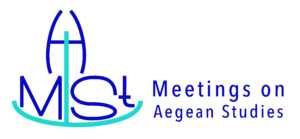
MASt (Meetings on Aegean Studies) was co-founded in 2019 by Gregory Nagy, Tom Palaima, and Rachele Pierini. Started as a collegial seminar, MASt quickly grew into a world-wide network in just three months. Today the MASt network involves 20+ institutions in 15+ time zones (from California to Australia) and maintains the friendly and collaborative atmosphere of the earliest encounters. Furthermore, the MASt team includes a project leader (Pierini), two editors (Pierini and Palaima), an editorial board, and a wide array of scholars who participate regularly (including Eric H. Cline, Janice Crowley, Hedvig Landenius Enegren, Brent Vine).
The three initiators shaped the MASt identity around the core values of passionate commitment, cooperation, fairness, growth, and openness. They used these core values to prioritize tasks, make decisions, design biannual plans, and forge the signature features of the MASt project. As a result, the MASt project is designed to boost specialized discussion on Bronze Age Aegean topics and enhance the connectedness between Prehistorians and Classicists and between the ancient world and today’s society. The MASt logo conveys these messages and values, and the MASt initiators designed a twofold strategy (that is, specialist seminars and open-access publications) to achieve MASt’s ambitious goals.
MASt offers quarterly online seminars in which two speakers present the latest results of their research on Bronze Age Aegean topics in a 20-minute talk. A 30-minute debate follows each presentation. In this timeframe, the participants, who all have a substantial expertise in Bronze Age Aegean matters, engage in discussion with the speakers and provide extensive feedback. Within two months of the specialist seminar, the MASt crew peer-review the papers and publish them along with substantial summaries of the discussion in the journal Classical Continuum, an online open-access periodical founded by Harvard University.
The MASt Logo
Introducing the newly designed MASt (Meetings on Aegean Studies) logo:
— The mast of a ship is a sturdy, vertical structure that supports its sails, flags, and antennae. MASt supports Aegean sails since the Bronze Age Aegean is the project’s scientific focus; supports all perspectives, backgrounds, and identity flags, as long as personal attacks are avoided; supports new approaches to Classics by pioneering wireless and online meeting as well as free and open-access contents since 2019.
— The mast is located near the center of a vessel and helps to balance the boat and keep it stable while it is under way. Additionally, the Greek word for ‘mast’ (i.e. histós) also means ‘beam of the loom’ since it stems from an Indo-European root indicating ‘to make stand, set up’. With its increasingly larger network, array of specialized areas and approaches, and intergenerational participation, MASt is designed to provide a safe space to set up new ideas for discussion and growth and aims to constitute a reference point for anyone passionately interested in navigating the challenging and open waters of the Aegean world, be they already on board or about to embark in this journey.
— Boats were essential tools for the Aegeans to explore, navigate, connect distant places, run business, discover new countries and cultures, bring people and societies together, communicate. The MASt boat is a symbol of connection, discovery, progress, mobility, communication. It represents the project’s values of passionate commitment, cooperation, growth, and openness and the project’s goals of expansion, community-building, interdisciplinarity, multilingualism and multiculturalism, connectedness, and public engagement.
— The shape of the second letter in MASt is based on the sign for a in Linear B, which is the only deciphered Aegean script to date and encodes the earliest form of the Greek language known to us (Mycenaean). Specific features of the Linear B sign have been emphasized to obtain a sign that is close to a capital A of the Latin alphabet. By undergoing this change, this letter represents the MASt’s goal to unravel the connectedness between the ancient and today’s world while focusing primarily on what is unique in the past and present and what is shared, what is still the same and what is different, what we can maintain and what has to be rethought to enter the future.
— The MASt colors are the natural colors of the beautiful Aegean sea, the colors that the Aegeans could, and we still can, enjoy. The elements in the green water color represent Aegean key features (i.e. the boat and the vertical stroke in the Linear B sign for a) and the elements in the blue color represent our contemporary approach to the Bronze Age Aegean through dedicated meetings and studies. The inner circle in green water represents the MASt focus on the past societies of the Aegean area and the outer circle in blue represents the MASt commitment to bring the 2nd millennium BCE into the 3rd millennium CE.